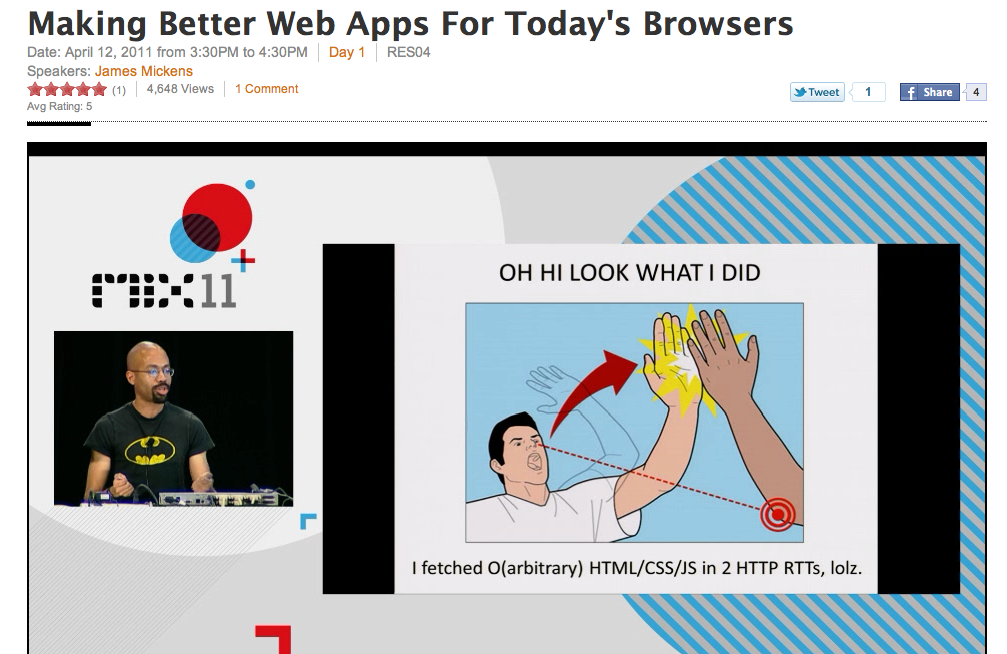University-level education has never really touched too directly on what we do as frontend developers. I know I was self-taught in the ways of the browser, as were all of my friends. Luckily the sort of webapp work we do these days is quite sophisticated so those CS graduates bring much of the great ideas to the JavaScript community. (Alex Sexton has been a personal inspiration here)
Early last year, something clicked in my head when I saw this video: Crossing the Chasm: Pitching Security Research to Mainstream Browser Vendors.
You mean.. there are academics… who are doing research on browsers.. in universities? My my! You mean bright minds think about the same things as us and don’t publish them on Octopress? ;)
Turns out it’s quite an active area of research. So, I’ve put together a list of academic papers, talks, and researchers all centered around frontend development and browsers (Please chime in on the comments if you know of more):
Webapps
Gibraltar: Exposing Hardware Devices to Web Pages Using AJAX UC San Diego, Microsoft Research, Univ. of Singapore, 2012
Modeling and Reasoning about DOM Events Brown University, 2012
Don’t Repeat Yourself: Automatically Synthesizing Client-side Validation Code for Web Applications University of Illinois at Chicago, 2012
Performance
Who Killed My Battery: Analyzing Mobile Browser Energy Consumption Stanford, 2012
How far can client-only solutions go for mobile browser speed? ACM Digital Library, 2012
Race Detection for Web Applications Sofia University & ETH Zurich & IBM T.J. Watson Research Center, 2012
Leo Meyerovich - Berkeley Rsearch UC Berkeley, 2009 (Parallel Browser Execution, Security)
James Mickens - Microsoft Research Microsoft, 2004- (Performance, localStorage, Mashups, Speculative Execution

Debugging & Tools
Timelapse - Interactive record/reply with Webkit inspector Univ. of Washington, 2012
Cleanroom: Edit-Time Error Detection with the Uniqueness Heuristic Univ. of Washington, 2010
Firebug Research - Academic papers related to Firebug Various, 2012
Realtime Performance Visualizations using Node.js How to NODE, 2011
How Programmers Debug, Revisited: An Information Foraging Theory Perspective Wentworth, OSU, & IBM TJ Watson Research Center, 2010
Security
Crossing the Chasm: Pitching Security Research to Mainstream Browser Vendors Carnegie Mellon, 2011
Benjamin Livshits - Microsoft Research Microsoft, 2004-2012 (Malware, Privacy, JS Benchmarking, JS Compression, JS Static Analysis, Security)
Dynamics of JavaScript Purdue, 2011
Adam Barth - Research Various, 2007- (XSS, CRSF, Security…)
Data Visualization
Highlights of the Infovis Conference, VisWeek 2011 2011
JavaScript
Gregor Richards - JS Research at Purdue Purdue, 2009-2011
Cleanroom University of British Columbia, 2011-2012
Anders Møller - Research Aarhus University, 2002-
Non-JavaScript Tooling
Whyline for Java Natural Programming, 2009
Stacks Plorer Media Computing Group, 2012
Omniscient debugging with TOD Pleiad, 2007
The Elm Programming Language Elm Lang, 2011-2012 (a type-safe, functional reactive language that compiles to HTML, CSS, and JavaScript)


